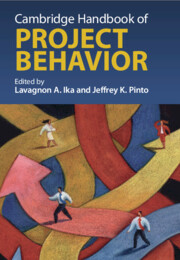Book contents
- Cambridge Handbook of Project Behavior
- Cambridge Handbook of Project Behavior
- Copyright page
- Contents
- Figures
- Tables
- Contributors
- Introduction
- Part I Guiding Principles
- Part II Deviating from Plans
- Part III Practical Tips
- Chapter 13 Setting Realistic Project Goals
- Chapter 14 At the Brink of a Project
- Chapter 15 The Roles of Governance Mechanisms to Manage Misbehaviors in the Project Front-End
- Chapter 16 Coping with Changes to the Plan
- Chapter 17 Project Behavior, Disruptions, and the Antifragility Spectrum
- Chapter 18 Curbing Cost Increases and Benefit Shortfalls
- Afterword
- Index
- References
Chapter 15 - The Roles of Governance Mechanisms to Manage Misbehaviors in the Project Front-End
from Part III - Practical Tips
Published online by Cambridge University Press: 22 November 2025
- Cambridge Handbook of Project Behavior
- Cambridge Handbook of Project Behavior
- Copyright page
- Contents
- Figures
- Tables
- Contributors
- Introduction
- Part I Guiding Principles
- Part II Deviating from Plans
- Part III Practical Tips
- Chapter 13 Setting Realistic Project Goals
- Chapter 14 At the Brink of a Project
- Chapter 15 The Roles of Governance Mechanisms to Manage Misbehaviors in the Project Front-End
- Chapter 16 Coping with Changes to the Plan
- Chapter 17 Project Behavior, Disruptions, and the Antifragility Spectrum
- Chapter 18 Curbing Cost Increases and Benefit Shortfalls
- Afterword
- Index
- References
Summary
The project front-end has long been understood as a project phase critical to overall project success. In this chapter, we investigate the underexplored topic of (mis-)behaviour in the project front-end. Drawing upon literature on contractual and relational governance mechanisms, we argue that traditional forms of project governance do not have strong applicability to help address some of the most important challenges facing the front-end of projects. This chapter commences by considering how misbehaviours can manifest and be present at different levels of analysis (macro, meso, micro). We then briefly review extant governance studies before considering how misbehaviours can be tackled through such (contractual and relational) governance mechanisms. We conclude our chapter by presenting a future research agenda to help further address the important and under-researched topic of project front-end misbehaviour.
Information
- Type
- Chapter
- Information
- Cambridge Handbook of Project Behavior , pp. 233 - 245Publisher: Cambridge University PressPrint publication year: 2025
References
Accessibility standard: WCAG 2.0 A
Why this information is here
This section outlines the accessibility features of this content - including support for screen readers, full keyboard navigation and high-contrast display options. This may not be relevant for you.Accessibility Information
Content Navigation
Allows you to navigate directly to chapters, sections, or non‐text items through a linked table of contents, reducing the need for extensive scrolling.
Provides an interactive index, letting you go straight to where a term or subject appears in the text without manual searching.
Reading Order & Textual Equivalents
You will encounter all content (including footnotes, captions, etc.) in a clear, sequential flow, making it easier to follow with assistive tools like screen readers.
You get concise descriptions (for images, charts, or media clips), ensuring you do not miss crucial information when visual or audio elements are not accessible.
You get more than just short alt text: you have comprehensive text equivalents, transcripts, captions, or audio descriptions for substantial non‐text content, which is especially helpful for complex visuals or multimedia.
You can access graphs or charts in a text or tabular format, so you are not excluded if you cannot process visual displays.
Visual Accessibility
You will still understand key ideas or prompts without relying solely on colour, which is especially helpful if you have colour vision deficiencies.
You benefit from high‐contrast text, which improves legibility if you have low vision or if you are reading in less‐than‐ideal lighting conditions.
